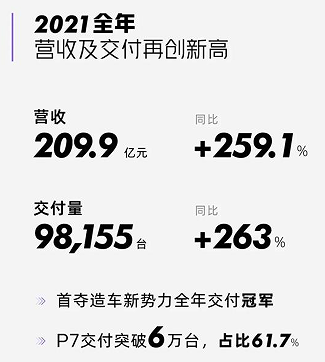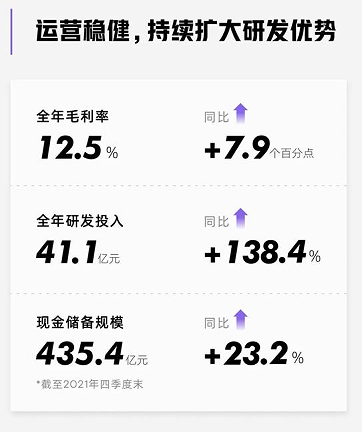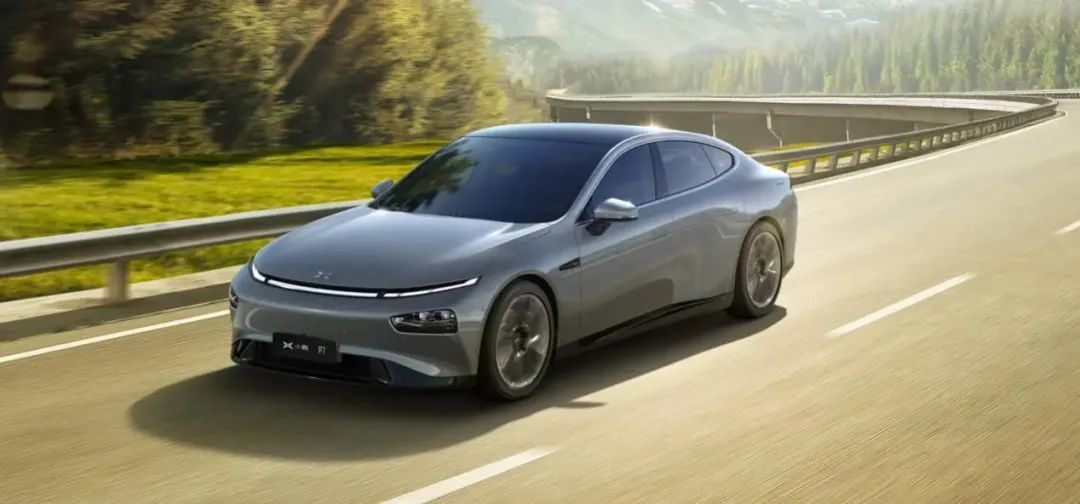Author: Su Qin
On March 28th, XPeng Motors released its 2021 financial report. The revenue of XPeng Motors was RMB 20.99 billion, an increase of 259.1% year-on-year. XPeng Motors delivered a total of 98,155 vehicles, a year-on-year increase of 263%, winning the annual delivery championship of new car-making forces for the first time. The gross profit margin was 12.5%, with a net loss of RMB 4.863 billion. In terms of profitability, it was relatively weak and urgently needed to reverse the continuous losses.
Faced with the complex and severe international political situation, as well as the continuous impact of issues such as chip shortage and rising raw material prices, He XPeng proposed in this financial report that XPeng Motors will launch two new platforms (C-level, B-level) in 2023 to cover the mainstream mid-to-high-end vehicle market. The mid-to-long-term goal is to increase the overall gross profit margin of the company to more than 25%. Is this an adventurous plan or a confidence in the comprehensive strength of the company?
Can One Success Lead to Another?
With a delivery volume of 60,569 vehicles, accounting for 61.7% of the total annual delivery volume, P7, as the main model, has been leading the way, and XPeng successfully won the annual sales championship of new car-making forces in 2021. In the future, XPeng will continue to focus on the mid-to-high-end market. Can the two new platform models continue the brilliance of P7? Can they help the enterprise turn losses into profits?

The challenges are severe and specific. Issues such as the funding chain problem of new car-making forces, supply chain management, the positioning of vehicle models, and the degree of acceptance by car owners are constantly affecting all aspects of the new car-making forces market. Faced with challenges, taking the lead and overcoming difficulties is XPeng’s consistent style. As early as 2018, when the new energy automobile market was mainly dominated by traditional automobile companies upgrading and transforming, XPeng Motors embarked on a road of independent research and development design from scratch, sparing no effort in launching P7, a mid-to-high-end model priced at 200,000-300,000 RMB. The excellent sales performance of P7 and the market performance in recent years have given us more expectations and confidence in XPeng’s new platform models in the future.
In 2023, XPeng Motors will launch two new platforms, combining its own technological research and development advantages, greatly improving cost control capabilities, and more widely covering mid-to-high-end market users. While inheriting XPeng Motors’ leading aesthetic design, electrification, and intelligent driving in the industry, the new platform will also create more advanced manufacturing processes, such as ultra-large integrated die casting.According to the Announcement on the Receipt of Xpeng’s Designated Development Notice by Its Wholly-owned Subsidiary, Shenzhen Borui Electronics Co. Ltd (Borui), Borui has become a supplier of related components for Xpeng’s F30 and E38 models, which are the main force of Xpeng’s new platform. Xpeng’s future vehicle planning has stepped into practical operation. As one of the most powerful private circuit board manufacturers in China, Borui’s market covers countries and regions such as the United States, the United Kingdom, Germany, Brazil, and Hong Kong. This cooperation will inevitably improve Xpeng’s competitive advantage in the high-tech field and further enhance the comprehensive performance and market share of Xpeng’s future models.
High R&D Investment Affects Profit Margin
Xpeng’s original intention is to “create a better travel life for consumers through intelligent manufacturing.” In the third quarter of 2021, Xpeng spent nearly 1.27 billion yuan on R&D, which is 1.8 times and more than 2 times the proportion of total expenditures than its rivals, NIO and Li Auto, respectively. However, in 2021, Xpeng’s gross profit margin was only 12.5%, lower than NIO and Li Auto’s margin of about 20%, with a net loss of 4.863 billion yuan. Despite continuous losses, Xpeng still increases the R&D strength and intensity of its intelligent driving system. Xpeng must make a choice between pursuing a larger profit margin and continuous high R&D investment.

He XPeng said that a truly intelligent car should be a car that can be deeply customized and with self-developed OS based on the integration of software and hardware during the car R&D stage. By the end of 2022, Xpeng’s multiple models will be equipped with XPILOT4.0 supported hardware, and by 2023, Xpeng will realize intelligent assisted driving in full-scene scenarios, including high-speed and urban areas.
According to the financial report, Xpeng’s R&D expenses increased significantly by 138.4% to 4.114 billion yuan, accounting for 19.6% of its revenue last year. Meanwhile, NIO invested 4.592 billion yuan in R&D, accounting for 12.7% of its revenue, and Li Auto invested 3.49 billion yuan in R&D, accounting for 12.9% of its revenue. Although the lower unit price of the car squeezed Xpeng’s profit margin, it did not affect Xpeng’s investment in R&D technology, as the development of core functionalities and first-class technical reserves are the guarantees of Xpeng’s future success.The core function of XPILOT3.5, City NGP, is progressing smoothly, and XPeng Motors plans to launch City NGP in the first batch of cities at the end of the second quarter of this year. Based on a new architecture, XPILOT3.5’s performance in the city scene far exceeded expectations and achieved a competitive edge over the domestic leading enterprise Robotaxi in comprehensive experience. He XPeng commented that “it is ahead of most companies by 2-3 years.” By the end of 2022, multiple models will be equipped with hardware that supports XPILOT4.0, and by 2023, intelligent assisted driving in all scenarios in high-speed and city driving will be realized. In fact, the NGP intelligent navigation assisted driving was open to users in the first quarter of last year. The penetration rate in high-speed traffic has been above 60% for a long time and has been well received by users.
Technological research and development are the fundamental basis for the long-term success of an enterprise. The market is more concerned about the profitability of the enterprise. He XPeng also gave his own expectations about the sales of different models. P7 will still be the main model of XPeng Motors, accounting for 62% of the total annual deliveries with 60,569 vehicles delivered throughout the year. It can also be ranked in the top three in B-grade pure electric cars, and is expected to achieve more than 10,000 deliveries in a single month this year. After the supply chain issue is alleviated, P5’s sales volume is expected to increase significantly. The G9 prototype has been offline, and it will be delivered and used in Q3 2022.
Market risks of price hikes
Price hikes are an objective requirement of the new energy vehicle industry and an inevitable trend in future market development. The larger the scale of the battery, the higher the percentage of the price hike, which is directly linked to cost. The battery accounts for about 50% of the cost increase, with the increase ranging from several thousand to tens of thousands of yuan. If prices are not raised, car companies will hardly make any profit, and the industry will face a shortage of batteries rather than out-of-stock. It is expected that the battery supply in China will be significantly improved in the second or third quarter of next year. He XPeng said, “There are still significant challenges in battery supply this year. The proportion of price hikes has exceeded our expectations, and we are still in communication.”
Regardless of vehicle model, sales volume, or R&D of core technologies for fully automated driving, it has always been an advantage of XPeng Motors among new forces. However, last year’s sales of nearly 100,000 vehicles still failed to reverse the situation of a loss of 4.863 billion yuan. The low unit price of the vehicle largely squeezed XPeng’s profit margin. XPeng’s average vehicle selling price in 2021 was 204,200 yuan, far lower than NIO’s 362,800 yuan and Li Auto’s 288,700 yuan average vehicle prices.
On March 21, 2022, XPeng Motors announced an overall price increase. Except for the 562E performance version of P7, which did not increase in price, other versions of the models have increased in price to varying degrees. Among them, the P7 model’s 670G, 670N, and 670N+ have the smallest increase of about 10,000 yuan. After the announcement of the price increase, XPeng’s overall order volume showed a surge in “last-minute” rush, with daily new orders increasing by thousands.In addition, XPeng Motors’ overseas plan is also an important support for future gross margin improvement, and the P5 model is synchronously available for pre-order in four countries: Denmark, the Netherlands, Norway and Sweden, which is regarded as a low-cost competitor of Tesla Model 3 by the market.
Achieving economies of scale in mass production of vehicles is a general understanding for the development of the automotive industry to achieve positive gross margin. The fame and impressive performance of the P7 has given us more expectations for XPeng’s two new platforms in the future. XPeng Motors has set a medium-to-long-term goal of increasing gross margin to 25%, which is not only a matter of future planning, but also a confidence in the enhancement of key core technology research and development, cost control, and overall market operation capability.
This article is a translation by ChatGPT of a Chinese report from 42HOW. If you have any questions about it, please email bd@42how.com.
